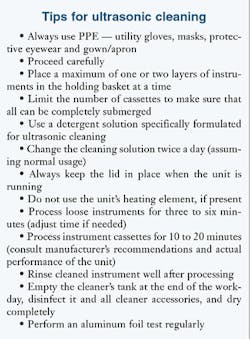It all begins with a good cleaning
Proper sterilization of orally soiled instruments is an essential component of a dental practice's infection control program. It helps assure patient safety. Debridement of instruments prior to sterilization greatly influences the chances of success by reducing the numbers of microorganisms present. Blood, saliva, plaque, calculus and dental materials can insulate microbes unless they are removed, thus jeopardizing sterilization effectiveness.
Proper personal protective equipment (PPE) must be worn when preparing instruments for sterilization. This includes heavy-duty utility gloves, a mask, protective eyewear, and some type of protective gown or apron.
Instrument preparation can be accomplished through the combined application of two cleansing processes — holding and cleaning.
Holding instruments
It is not always possible to clean soiled instruments immediately after dismissing the patient. However, saliva and blood components should not be allowed to dry on dental instruments. "Holding" instruments means keeping them wet until they can be thoroughly cleaned. Ideally, holding can be accomplished by immersion in ultrasonic cleaning solutions. These solutions contain effective detergents and often possess anti-rust chemicals. Unlike many household detergents, ultrasonic cleaning solutions have pH values that do not harm metals. Holding should be limited to less than three hours to minimize corrosion of carbon steel instruments. Instruments should be carefully rinsed after soaking in a holding solution. For safer handling, use a basket from an ultrasonic cleaner.
There are risks associated with handling dental instruments, even when wearing utility gloves. PPE does not protect against all occupational exposures. Work practice controls that reduce the likelihood of exposure by altering the manner in which a task is performed are needed. For example, additional time could be allotted for instrument cleaning.
Cleaning instruments
Traditionally, dental instruments have been cleaned through manual scrubbing and mechanical cleaning. Routine hand scrubbing of dental instruments is not recommended, however. Hand scrubbing poses greater risks of occupational exposure and is not as effective as automated cleaning. Efficiency is decreased because workers are not free to perform other tasks while hand scrubbing.
It is best to reserve hand scrubbing for a very limited number of instruments that remain soiled after mechanical cleaning.
Most dental practices today have an ultrasonic cleaner. The cavitation action of an ultrasonic cleaner produces a cleansing turbulence that disrupts and removes adherent materials. Almost all reusable dental instruments can be cleaned by ultrasound; handpieces are usually the exception. Both loose instruments and instruments held in cassettes can be cleaned in an ultrasonic cleaner.
Always review the instructions provided by the manufacturer. All instruments (loose or in cassettes) must be suspended in the ultrasonic cleaning solution by using a rack or basket. This maximizes cleaning and holds the instruments off the bottom of the chamber, where excessive bouncing could damage instruments or the unit. Only detergents designed for use in an ultrasonic cleaner should be used. Although more expensive than household solutions, these detergents last longer, are more benign to instruments, and produce greater cavitation action.
A simple method to test the cavitation action of an ultrasonic cleaner uses a piece of household aluminum foil. Lay a four-inch square onto a flat surface and use a finger to smooth away wrinkles. Immerse the foil halfway into the cleaning solution and activate the unit. After 15 to 30 seconds, remove the foil. If the immersed portion of the foil is uniformly roughened and pitted, or it shows small holes, the unit is functioning properly. If the foil appears smooth in some areas, the ultrasonic cleaner may require servicing.
Another automated method for cleaning instruments is an instrument washer (sometimes also called a "washer-disinfector.") Instrument washers are generally large devices approximately the size of household dishwashers. They are specially designed to generate and withstand very high water temperatures, aggressive rinsing, and exposure to strong detergents. Cycle times approach one hour. These units have very large capacities (15 to 20 instruments cassettes).
After cleaning, instruments appear free of debris. But it is important to remember that cleaned instruments are not sterile. This means that proper PPE and work practice controls must be used. More information on instrument processing is available in the Organization for Safety & Asepsis Procedures' (OSAP) position paper on instrument processing. It is available at no charge via the OSAP website (www.osap.org/issues/pages/position/pp-ip.htm).
null
Charles John Palenik, MS, PhD, is an assistant director of Infection Control Research and Services at the Indiana University School of Dentistry. Dr. Palenik has authored numerous articles, book chapters and monographs, and is the co-author of the popular Infection Control and Management of Hazardous Materials for the Dental Team. He serves on the Executive Board of OSAP, dentistry's resource for infection control and safety.Questions about this article or any infection control issue may be directed to [email protected].

